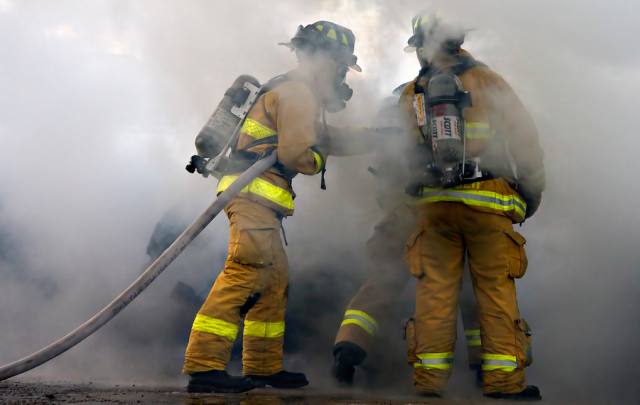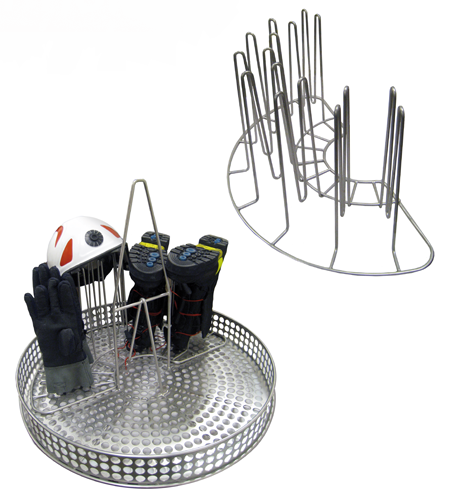Sponsored content from RESCUE Intellitech
By: Robert Avsec, Executive Fire Officer

One of the primary strategies that fire departments are employing for reducing the risk of exposures to their people from the hazards of structural firefighting is the laundering of PPE following all significant exposures to those identified hazards.
Washer/extractor machines are becoming more commonplace in fire stations, along with options for active drying (mechanical dryers and drying cabinets) and passive drying (Designated PPE storage rooms, open air lockers).
But does your fire department’s strategy for cleaning PPE include all the elements of the structural firefighting protective ensemble? What about your boots, helmet, and gloves? And your SCBA?
Protection from Exposure During Cleaning
One of the “unsung” benefits of the washer/extractor for cleaning the coat, pants, and hood elements of the protective ensemble is that machine laundering significantly reduces your exposure to those toxic chemicals, chemical compounds, and carcinogens as they’re released from the fabric of those elements during the laundering process. It’s all taking place in a closed system and everything goes down the drain into the sanitary sewer system.
There’s been no comparable closed system for cleaning your SCBA, boots, gloves, and helmet. Until now.
The Solo Rescue SCBA Cleaning Machine
The Solo Rescue® SCBA Cleaning Machine from Sweden-based RESCUE Intellitech AB features a rotating basket that enables the water jets to reach and decontaminate even tight and sometimes hard to reach spaces, such as between the back plate and the air cylinder. For cleaning and decontaminating soiled SCBA, the Solo Rescue® system gives your fire department the right stool to:
- Reduce the risk of exposure to personnel from combustion gases, soot particles, and toxins that get released in the cleaning process. With the Solo Rescue® system, there’s no need to disassemble the SCBA unit. Just load your SCBA into the machine, close the door, and push the START button.
- Reduce the exposure risk to personnel because they don’t have to handle buckets or tubs, brushes, and rags typically used to clean SCBA by hand. And they don’t have to handle contaminated wash water either. With the Solo Rescue® system, all the water stays inside the machine until the operator releases it into the sanitary sewer system.
There’s More than Just SCBA to Be Cleaned
Imagine what your firefighting and station boots bring back to the fire station, and not just from structure fire calls. Don’t forget the road debris, petroleum residue, contaminated mud and dirt, and blood and body fluids that get picked up from working at motor vehicle crashes, brush fires, and other fires that don’t involve structures.
And let’s not forget your helmet and gloves. Both PPE elements get heavy exposure during structural firefighting and those other types of calls as well.
What About Cleaning Those Other PPE Elements?
NFPA 1851: Standard on Selection, Care, and Maintenance of Protective Ensembles for Structural Fire Fighting and Proximity Fire Fighting doesn’t provide specific guidelines for cleaning firefighter boots to the degree that the standard addresses cleaning for turnout coats and pants.
In a July 2018 interview for FireRescue1.com, Pat Freeman, Technical Services Manager at Globe Manufacturing, spoke about the normal cleaning, such as removing surface debris from a structural fire, for firefighting boots. According to Freeman, Globe recommends that its customers to use a soft sponge or rag with warm water to remove surface dirt, and then rinse thoroughly with clear water (There’s those contaminated buckets, brushes, and rags again!).
During that interview, Freeman stated that Globe normally advises against using soap or detergents for everyday cleaning. She went on to say that if a boot requires specialized cleaning, Globe then recommends the sparing use of a very mild dishwashing detergent solution and then rinse the boots off as soon as possible with clear water.
The same can be said for your helmet and gloves. Most manufacturers are recommending handwashing with mild soapy water and a thorough rinse with clean water.
So, what’s the solution? There has to be a better way, right?
Solo Rescue (To the Rescue!)

And there is. The Solo Rescue® SCBA Cleaning Machine is more than just a SCBA cleaning machine. It’s really the “Yin” to your fire station’s washer/extractor’s “Yang.” By simply changing the insert, the Solo Rescue® SCBA Cleaning Machine, becomes the Solo Rescue® “Clean Everything but the Kitchen Sink” Machine.
The washer has a second wash/rinse cycle specifically for the cleaning of helmets, gloves, and boots (3 minutes instead of the longer 8 minutes for the SCBA wash/rinse cycle). Depending upon whether you use one or two of the inserts, the Solo Rescue® SCBA Cleaning Machine gives your fire department the capacity to clean:

- Helmets (maximum of five helmets/insert)
- Up to 12 helmets/hour (using one insert)
- Up to 24 helmets/hour (using two inserts)
- Firefighting Gloves
- Up to 80 pairs of gloves/hour (using one insert)
- Up to 160 pairs of gloves/hour (using two inserts)
- Boots
- Up to 30 pairs of boots (using one insert)
- Up to 60 pairs of boots (using two inserts)
(The Solo Rescue® SCBA Cleaning Machine comes with one insert standard. A second insert can be purchased separately)
So, there you have it. The remaining part of your fire department’s PPE cleaning challenge—how to safely, effectively, and efficiently clean SCBA, helmets, gloves, and boots—can be solved with one mechanical solution, the Solo Rescue® SCBA (And So Much More!) Cleaning Machine.
 Fire & EMS Leader Pro The job of old firefighters is to teach young firefighters how to become old firefighters!
Fire & EMS Leader Pro The job of old firefighters is to teach young firefighters how to become old firefighters!